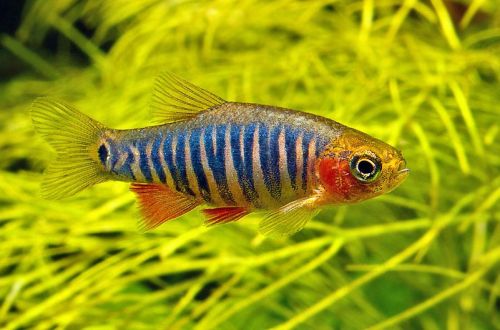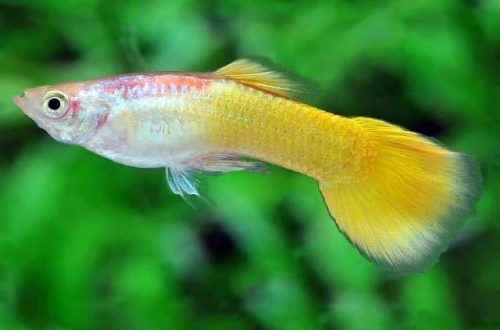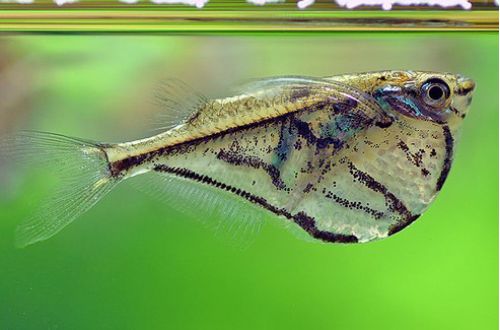
Emerald Danio
The Emerald Danio, scientific name Danio erythromicron, belongs to the Cyprinidae family. Previously erroneously named as Microrasbora emerald or Microrasbora erythromicron (Microrasbora erythromicron). In the course of detailed studies in the early 2000s, according to a number of features, these fish were assigned to the Danio group. However, the old names are still used and can be found in obsolete literature and on some websites.

Contents
Habitat
It comes from Southeast Asia from the territory of central Myanmar. It lives in Inle Lake, located in a mountainous area at an altitude of 900 m above sea level in the Shan Plateau region. The lake has a shallow depth, only 2–3 meters, a loamy substrate, the water is clear, but along the banks it can be cloudy due to suspended silt. “Vegetable islands” of clusters of aquatic plants float on the surface of the water, serving as a home for many species of fish, including the Emerald Danio.
Brief information:
- The volume of the aquarium – from 50 liters.
- Temperature – 20-24°C
- Value pH — 7.0–8.0
- Water hardness – 12–21 dGH
- Substrate type – soft dark
- Lighting – subdued
- Brackish water – no
- Water movement – little or no
- The size of the fish is about 2 cm.
- Feeding – any food of suitable size
- Temperament – peaceful
- Content in a group of 20 individuals
Description
Adult individuals reach a length of about 2 cm. The color of the body consists of alternating transverse stripes of blue-emerald and orange colors. The ventral and anal fins are red, the rest are translucent. A black dot is visible at the base of the tail. Sexual dimorphism is weakly expressed. Males are very similar in appearance to females. The latter look somewhat larger, which is especially noticeable during the spawning period, when they are filled with caviar.
Food
They prefer a varied diet consisting of various foods of suitable size. For example, a combination of dry flakes, granules with live or frozen artemia, daphnia, bloodworms.
Maintenance and care, arrangement of the aquarium
They are kept in large groups, therefore, despite the small size, the volume of the aquarium should start from 50–60 liters. The design uses a soft dark substrate, driftwood and other decorative elements, a large number of aquatic plants, including floating ones, which will be a great addition and serve as a good means of shading. The lighting is subdued.
The key to successful keeping of the Emerald Danio is to provide stable water conditions with suitable temperatures, pH and dGH. To achieve this goal, it is necessary to regularly carry out several standard aquarium maintenance procedures. In particular: weekly replacement of part of the water with fresh water, timely removal of organic waste (excrement, food debris), equipment maintenance, etc. It is permissible to use airlift filters as a filtration system, which, among other things, can increase the level of dissolved oxygen, which is especially important in the presence of a large number of living plants. At night, when photosynthesis stops, plants begin to absorb oxygen and release carbon dioxide, which can lead to suffocation in fish as a result.
Behavior and Compatibility
Peaceful mobile fish, prefer to be in a flock of 20 or more individuals. Intraspecific relationships are built on competition between males, sometimes quite fierce, which cannot be said when looking at these miniature fish. When in a large group, weaker individuals will be in relative safety, since the attention of alpha males will be scattered on other relatives.
Due to their size, the choice of aquarium neighbors must be treated with great attention. Danios can only be compatible with species of comparable size. Any large fish, even if it is a peaceful vegetarian, can accidentally eat them.
Breeding / breeding
In nature, fish breed all year round. In a home aquarium, under favorable conditions, spawning can also occur on a regular basis. Fish release several dozen eggs among the thickets of plants. They are equipped with adhesive threads, with which they are attached to any surface. The incubation period lasts about 72 hours, its duration depends on the water temperature. After another 3-4 days, the fry that have appeared begin to swim freely.
It is worth noting that the fish do not show parental care and, on occasion, are able to eat their own offspring, so if the fry are not transplanted into a separate tank in a timely manner, they will not live to adulthood.
Fish diseases
In a balanced aquarium ecosystem with species-specific conditions, diseases rarely occur. Often, diseases are caused by environmental degradation, contact with sick fish, and injuries. If this could not be avoided and the fish shows clear signs of illness, then medical treatment will be required. Read more about symptoms and treatments in the Aquarium Fish Diseases section.





